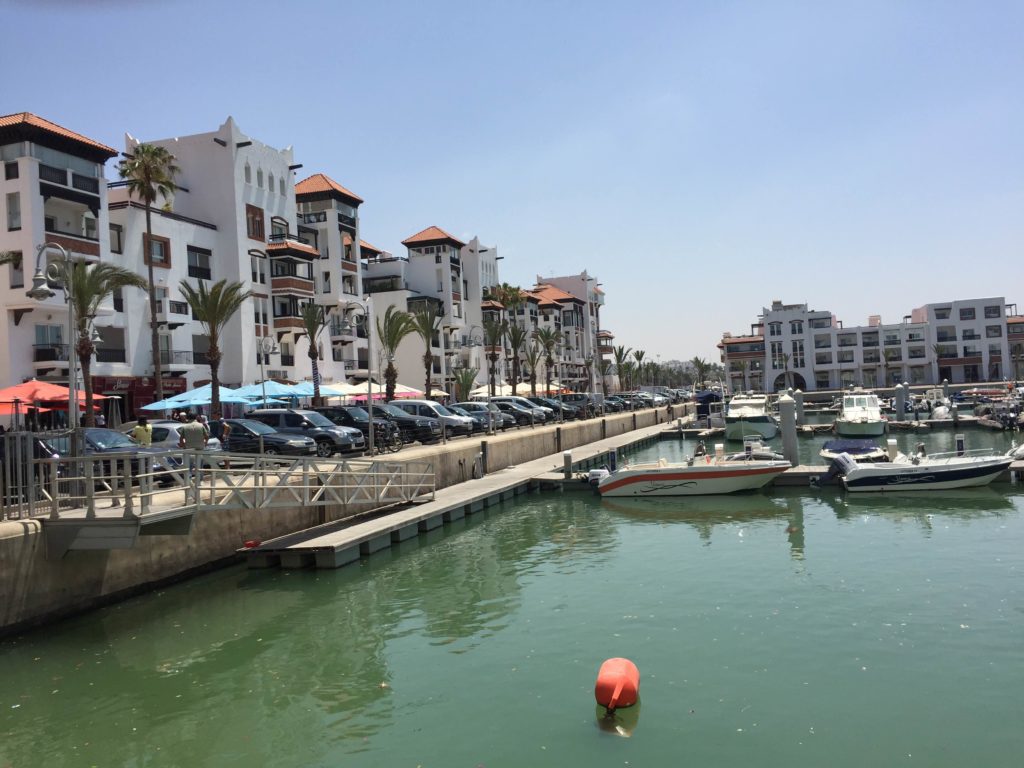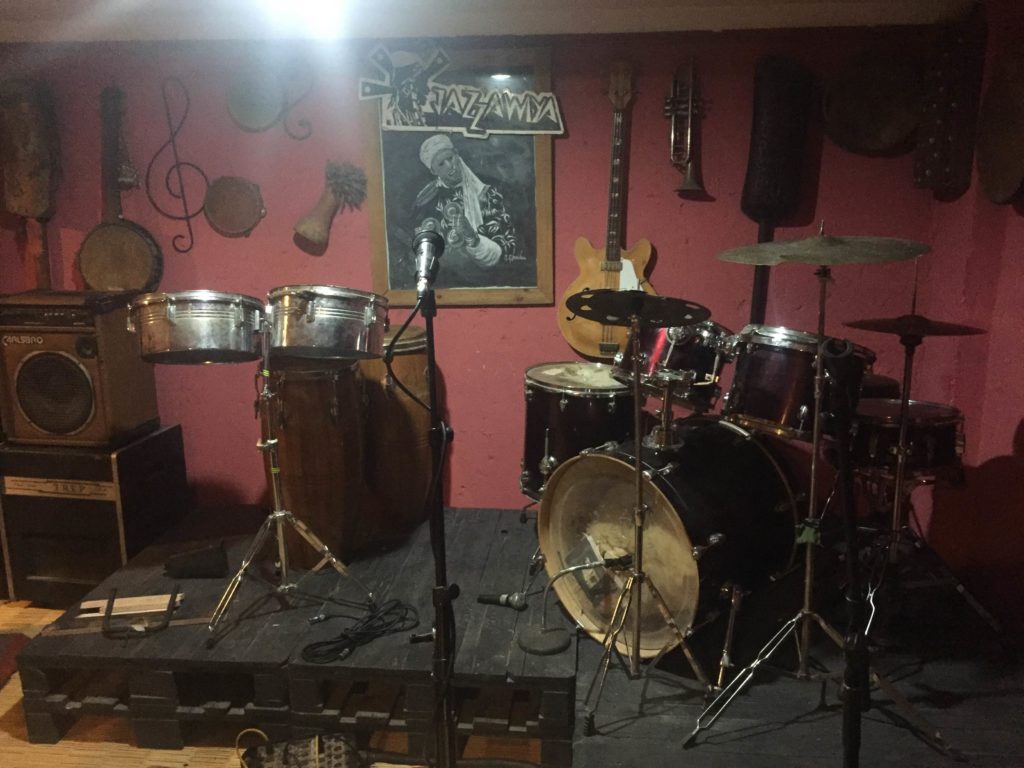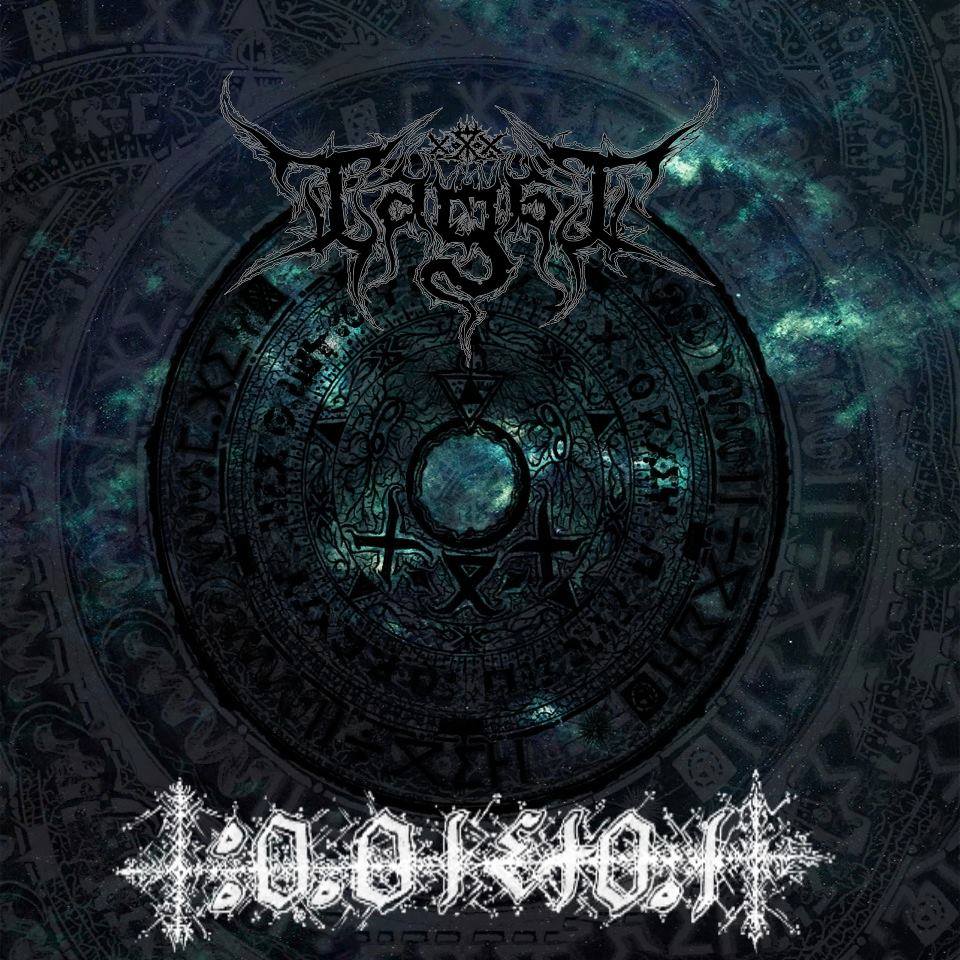Blog July 11, 2016
Morocco Dispatch No.1: True Amazigh Black Metal
Producer Jesse Brent is currently in Morocco, checking out the country's spectacular music scene, and talking to some of the country's most interesting and creative musicians. We'll feature more reports from him in the future. All photos by Jesse Brent.
 I met Oshen and Ulzasen, members of Tagat, Morocco’s only Amazigh black metal band, outside of a Carrefour grocery store in the Charaf neighborhood of Agadir, a stunning city on the Atlantic coast of southern Morocco. Rebuilt after an earthquake demolished the city in 1960, Agadir is an economic and cultural capital of one of Morocco’s richest regions--renowned for both its argan oil--the highly sought after culinary and beauty product--and a fantastic, diverse music scene. I had originally heard of Tagat from the excellent, though apparently now defunct, North African music blog Black Spring (whose founder Christophe Hancox I interviewed two years ago). While many people unfairly associate black metal with Satanism and church burnings in Norway, Oshen and Ulzasen’s music is not Satanic, but rather proudly draws from Amazigh culture, history, and mythology. Imazighen (plural of Amazigh) are the original people of North Africa, who have faced centuries of political and cultural colonization. The name Tagat, which means “curse” or “malediction” in the Amazigh language, Tamazight, references this history of colonization and struggle against invaders. Oshen and Ulzasen found parallels between the experience of the Amazigh and Viking warriors, who inspired many Scandinavian black metal bands. As Oshen, Tagat’s guitarist and singer told me, “It’s a modern war to protect our culture from disappearing. It’s a kind of war.”
Tagat sings in Tamazight about nature, history, Amazigh pride and mythology, including the story of Dihya (or Kahina), the Amazigh queen who led the resistance to the Arab conquest of North Africa in the seventh century. In one of their songs, Tagat sing about the Amazigh myth of the rainbow, wife of the god of rain, Anzar. They also sing about the history of Jewish “witchery” or Kaballah, which thrived in the region surrounding Agadir in the 12th and 13th centuries. Ulzasen, Tagat's multi-instrumentalist and lyricist, told me, “Black metal for me is like [studying] in the school of life.” Another black metal project based in Agadir, Abnabak, is a one-man band led by Aggor, who draws from the works of North African philosophers like St. Augustine and Ibn Khaldun. For both projects, Tagat and Abnabak dedicate themselves to a truly underground, independent spirit--refraining from using their real names or official photos for publicity, and playing all instruments, handling all production and creating all their artwork by themselves. So far, they have yet to perform live. Nevertheless, they have received positive attention from other black metal artists and fans in Europe--Abnabak released a split EP with the Finnish group Mormânt de Snagov. In addition to the project they already have underway, Oshen and Ulzasen are also working on a new folk black metal project, using Amazigh folk melodies and instruments.
Agadir’s music scene encourages stylistic exchange and innovation, especially in Jazzawiya, a unique musician’s hangout and performance space with a funky, eclectic atmosphere, where Oshen and Ulzasen brought me for our interview. When we entered Jazzawiya, musicians from different generations and musical backgrounds sat around a table, drinking mint tea, smoking long pipes and sharing ideas and stories. Downstairs, there is a small, but comfortable space for musicians to practice and perform. Sometimes, concerts are organized in advance, but often, musicians just break into loose impromptu jam sessions--feeding off of each other’s creative energy. It’s truly a special place.
I met Oshen and Ulzasen, members of Tagat, Morocco’s only Amazigh black metal band, outside of a Carrefour grocery store in the Charaf neighborhood of Agadir, a stunning city on the Atlantic coast of southern Morocco. Rebuilt after an earthquake demolished the city in 1960, Agadir is an economic and cultural capital of one of Morocco’s richest regions--renowned for both its argan oil--the highly sought after culinary and beauty product--and a fantastic, diverse music scene. I had originally heard of Tagat from the excellent, though apparently now defunct, North African music blog Black Spring (whose founder Christophe Hancox I interviewed two years ago). While many people unfairly associate black metal with Satanism and church burnings in Norway, Oshen and Ulzasen’s music is not Satanic, but rather proudly draws from Amazigh culture, history, and mythology. Imazighen (plural of Amazigh) are the original people of North Africa, who have faced centuries of political and cultural colonization. The name Tagat, which means “curse” or “malediction” in the Amazigh language, Tamazight, references this history of colonization and struggle against invaders. Oshen and Ulzasen found parallels between the experience of the Amazigh and Viking warriors, who inspired many Scandinavian black metal bands. As Oshen, Tagat’s guitarist and singer told me, “It’s a modern war to protect our culture from disappearing. It’s a kind of war.”
Tagat sings in Tamazight about nature, history, Amazigh pride and mythology, including the story of Dihya (or Kahina), the Amazigh queen who led the resistance to the Arab conquest of North Africa in the seventh century. In one of their songs, Tagat sing about the Amazigh myth of the rainbow, wife of the god of rain, Anzar. They also sing about the history of Jewish “witchery” or Kaballah, which thrived in the region surrounding Agadir in the 12th and 13th centuries. Ulzasen, Tagat's multi-instrumentalist and lyricist, told me, “Black metal for me is like [studying] in the school of life.” Another black metal project based in Agadir, Abnabak, is a one-man band led by Aggor, who draws from the works of North African philosophers like St. Augustine and Ibn Khaldun. For both projects, Tagat and Abnabak dedicate themselves to a truly underground, independent spirit--refraining from using their real names or official photos for publicity, and playing all instruments, handling all production and creating all their artwork by themselves. So far, they have yet to perform live. Nevertheless, they have received positive attention from other black metal artists and fans in Europe--Abnabak released a split EP with the Finnish group Mormânt de Snagov. In addition to the project they already have underway, Oshen and Ulzasen are also working on a new folk black metal project, using Amazigh folk melodies and instruments.
Agadir’s music scene encourages stylistic exchange and innovation, especially in Jazzawiya, a unique musician’s hangout and performance space with a funky, eclectic atmosphere, where Oshen and Ulzasen brought me for our interview. When we entered Jazzawiya, musicians from different generations and musical backgrounds sat around a table, drinking mint tea, smoking long pipes and sharing ideas and stories. Downstairs, there is a small, but comfortable space for musicians to practice and perform. Sometimes, concerts are organized in advance, but often, musicians just break into loose impromptu jam sessions--feeding off of each other’s creative energy. It’s truly a special place.

 I met Oshen and Ulzasen, members of Tagat, Morocco’s only Amazigh black metal band, outside of a Carrefour grocery store in the Charaf neighborhood of Agadir, a stunning city on the Atlantic coast of southern Morocco. Rebuilt after an earthquake demolished the city in 1960, Agadir is an economic and cultural capital of one of Morocco’s richest regions--renowned for both its argan oil--the highly sought after culinary and beauty product--and a fantastic, diverse music scene. I had originally heard of Tagat from the excellent, though apparently now defunct, North African music blog Black Spring (whose founder Christophe Hancox I interviewed two years ago). While many people unfairly associate black metal with Satanism and church burnings in Norway, Oshen and Ulzasen’s music is not Satanic, but rather proudly draws from Amazigh culture, history, and mythology. Imazighen (plural of Amazigh) are the original people of North Africa, who have faced centuries of political and cultural colonization. The name Tagat, which means “curse” or “malediction” in the Amazigh language, Tamazight, references this history of colonization and struggle against invaders. Oshen and Ulzasen found parallels between the experience of the Amazigh and Viking warriors, who inspired many Scandinavian black metal bands. As Oshen, Tagat’s guitarist and singer told me, “It’s a modern war to protect our culture from disappearing. It’s a kind of war.”
Tagat sings in Tamazight about nature, history, Amazigh pride and mythology, including the story of Dihya (or Kahina), the Amazigh queen who led the resistance to the Arab conquest of North Africa in the seventh century. In one of their songs, Tagat sing about the Amazigh myth of the rainbow, wife of the god of rain, Anzar. They also sing about the history of Jewish “witchery” or Kaballah, which thrived in the region surrounding Agadir in the 12th and 13th centuries. Ulzasen, Tagat's multi-instrumentalist and lyricist, told me, “Black metal for me is like [studying] in the school of life.” Another black metal project based in Agadir, Abnabak, is a one-man band led by Aggor, who draws from the works of North African philosophers like St. Augustine and Ibn Khaldun. For both projects, Tagat and Abnabak dedicate themselves to a truly underground, independent spirit--refraining from using their real names or official photos for publicity, and playing all instruments, handling all production and creating all their artwork by themselves. So far, they have yet to perform live. Nevertheless, they have received positive attention from other black metal artists and fans in Europe--Abnabak released a split EP with the Finnish group Mormânt de Snagov. In addition to the project they already have underway, Oshen and Ulzasen are also working on a new folk black metal project, using Amazigh folk melodies and instruments.
Agadir’s music scene encourages stylistic exchange and innovation, especially in Jazzawiya, a unique musician’s hangout and performance space with a funky, eclectic atmosphere, where Oshen and Ulzasen brought me for our interview. When we entered Jazzawiya, musicians from different generations and musical backgrounds sat around a table, drinking mint tea, smoking long pipes and sharing ideas and stories. Downstairs, there is a small, but comfortable space for musicians to practice and perform. Sometimes, concerts are organized in advance, but often, musicians just break into loose impromptu jam sessions--feeding off of each other’s creative energy. It’s truly a special place.
I met Oshen and Ulzasen, members of Tagat, Morocco’s only Amazigh black metal band, outside of a Carrefour grocery store in the Charaf neighborhood of Agadir, a stunning city on the Atlantic coast of southern Morocco. Rebuilt after an earthquake demolished the city in 1960, Agadir is an economic and cultural capital of one of Morocco’s richest regions--renowned for both its argan oil--the highly sought after culinary and beauty product--and a fantastic, diverse music scene. I had originally heard of Tagat from the excellent, though apparently now defunct, North African music blog Black Spring (whose founder Christophe Hancox I interviewed two years ago). While many people unfairly associate black metal with Satanism and church burnings in Norway, Oshen and Ulzasen’s music is not Satanic, but rather proudly draws from Amazigh culture, history, and mythology. Imazighen (plural of Amazigh) are the original people of North Africa, who have faced centuries of political and cultural colonization. The name Tagat, which means “curse” or “malediction” in the Amazigh language, Tamazight, references this history of colonization and struggle against invaders. Oshen and Ulzasen found parallels between the experience of the Amazigh and Viking warriors, who inspired many Scandinavian black metal bands. As Oshen, Tagat’s guitarist and singer told me, “It’s a modern war to protect our culture from disappearing. It’s a kind of war.”
Tagat sings in Tamazight about nature, history, Amazigh pride and mythology, including the story of Dihya (or Kahina), the Amazigh queen who led the resistance to the Arab conquest of North Africa in the seventh century. In one of their songs, Tagat sing about the Amazigh myth of the rainbow, wife of the god of rain, Anzar. They also sing about the history of Jewish “witchery” or Kaballah, which thrived in the region surrounding Agadir in the 12th and 13th centuries. Ulzasen, Tagat's multi-instrumentalist and lyricist, told me, “Black metal for me is like [studying] in the school of life.” Another black metal project based in Agadir, Abnabak, is a one-man band led by Aggor, who draws from the works of North African philosophers like St. Augustine and Ibn Khaldun. For both projects, Tagat and Abnabak dedicate themselves to a truly underground, independent spirit--refraining from using their real names or official photos for publicity, and playing all instruments, handling all production and creating all their artwork by themselves. So far, they have yet to perform live. Nevertheless, they have received positive attention from other black metal artists and fans in Europe--Abnabak released a split EP with the Finnish group Mormânt de Snagov. In addition to the project they already have underway, Oshen and Ulzasen are also working on a new folk black metal project, using Amazigh folk melodies and instruments.
Agadir’s music scene encourages stylistic exchange and innovation, especially in Jazzawiya, a unique musician’s hangout and performance space with a funky, eclectic atmosphere, where Oshen and Ulzasen brought me for our interview. When we entered Jazzawiya, musicians from different generations and musical backgrounds sat around a table, drinking mint tea, smoking long pipes and sharing ideas and stories. Downstairs, there is a small, but comfortable space for musicians to practice and perform. Sometimes, concerts are organized in advance, but often, musicians just break into loose impromptu jam sessions--feeding off of each other’s creative energy. It’s truly a special place.









